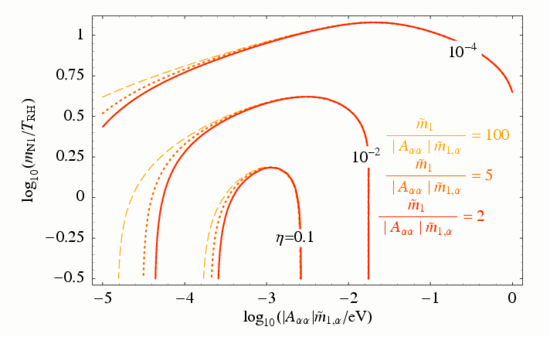Flavour-dependent leptogenesis efficiency factors
Here we provide numerical results for the efficiency factor for thermal leptogenesis within the MSSM. Flavour-dependent effects as well as effects of the reheating temperature of the early universe are included in the Boltzmann equations. Please consult our paper hep-ph/0611232 for details on the calculation and the used approximations and assumptions, as well as for references on the literature on flavour-dependent leptogenesis.
The relevance of the flavour-dependent effects depends on the temperatures at which thermal leptogenesis takes place, and thus on which interactions mediated by the charged lepton Yukawa couplings are in thermal equilibrium (for a summary of these temperature ranges see e.g. section 2.1 in hep-ph/0609038).
The following files are provided:
Numerical results in a Mathematica table (download file). The results are given as lists with the entries

- Mathematica notebook which interpolates the above table to obtain a function for the flavour-specific efficiency factor (download file).

The function obtained this way provides a very good approximation to the real numerical results. With this function one can, for example, reproduce the plot in figure 1 of hep-ph/0611232 for the flavour-specific efficiency factor, which is shown below.

The function can also be used to estimate baryogenesis via flavour-dependent thermal leptogenesis in models of fermion masses and mixings within the type I seesaw framework (see e.g. hep-ph/0609038), as well as in type II seesaw scenarios (see e.g. arXiv:0704.1591), if the mass of the lightest right-handed neutrino is much lighter than the other heavy particles contributing to neutrino masses. A brief description of how to estimate the produced baryon asymmetry from the efficiency factors and decay asymmetries of the distinguishable flavours can be found, for example, in section 3.1 of hep-ph/0611232. Please keep in mind that various assumptions and approximations were used to obtain these results, as summarised and discussed in section 3.1.3 of hep-ph/0611232.
